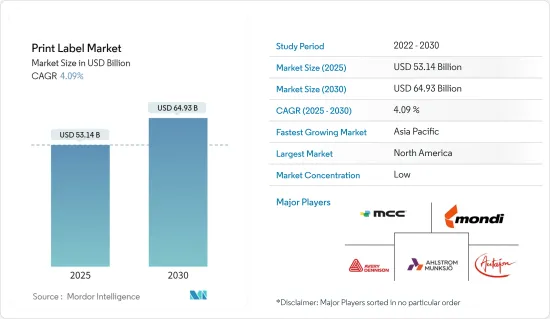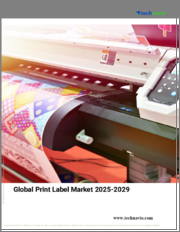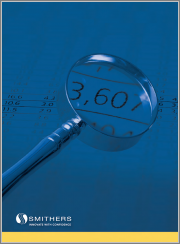
|
시장보고서
상품코드
1639480
인쇄 라벨 : 시장 점유율 분석, 산업 동향 및 통계, 성장 예측(2025-2030년)Print Label - Market Share Analysis, Industry Trends & Statistics, Growth Forecasts (2025 - 2030) |
||||||
인쇄 라벨 시장 규모는 2025년에 531억 4,000만 달러로 추정되며, 예측 기간(2025-2030년) 동안 4.09%의 CAGR로 2030년에는 649억 3,000만 달러에 달할 것으로 예상됩니다.

인쇄 라벨 시장은 보다 매력적인 브랜드에 대한 수요가 급증하고 있습니다. 이러한 배경에는 SKU 증가, 제품 수명주기 단축, 라벨에 대한 규제 요건 강화 등 여러 가지 요인이 있습니다. 또한, 제조품에 대한 수요가 증가하고 가처분 소득이 증가함에 따라 인쇄 라벨 시장은 더욱 확대될 태세를 갖추고 있습니다.
Nilpeter, Xeikon, Bobst Firenze 등 여러 주요 기업들은 디지털 라벨이 시장의 수요를 충족시킬 뿐만 아니라 기존 인쇄 방식보다 우수하다고 주장하고 있습니다.
디지털 기술은 소비자를 사로잡는 매력적인 라벨 디자인을 만들고 다양한 산업 분야의 요구를 충족시키는 데 탁월한 것으로 입증되었습니다. 디지털 기술을 기존 인쇄 방식과 통합함으로써 모든 규모의 산업 분야에 혁명을 가져올 것으로 기대되는 반면, 엄격한 환경 라벨 규제가 도전과제가 되고 있습니다.
라벨 부착의 어려움은 주로 온도와 습도 등의 환경적 요인에 기인하므로 주의 깊게 다루어야 합니다. 라벨은 건조한 실온 조건에서 부착하는 것이 가장 효과적이지만, 극한의 환경, 특히 겨울이나 여름 또는 저온 저장고에서 부착하는 것은 어렵습니다.
시장 관계자들은 판매 및 유통 채널을 두 배로 늘리고 있습니다. 예를 들어, 상하이에 위치한 제이콘의 혁신 센터는 중국의 확대되는 수요에 대응하여 애플리케이션 테스트 및 새로운 수익원 발굴을 위한 플랫폼을 제공하고 있습니다. 한편, 도미노는 디지털 인쇄 부문을 강화하고 있으며, 이는 최근 북미에서의 서비스 채택으로 나타나고 있습니다.
팬데믹으로 인해 라벨 회사들은 생산성 향상과 원격 고객 지원 제공이라는 두 가지 큰 장애물을 극복해야 하는 과제를 해결해야 했습니다. 팬데믹 이후 수요가 급증하면서 기업들은 생산능력의 압박에 직면했고, 제품 수명주기 전반에 걸쳐 자동화의 시급성을 강조했습니다.
인쇄 라벨 시장 동향
예측 기간 동안 식품 산업은 큰 수요를 창출할 것입니다.
- 식품 산업은 향후 몇 년 동안 인쇄 라벨 시장을 독점하게 될 것입니다. 오늘날 소비자들은 식품의 내용물에 대한 인식이 높아지고 있습니다. 이 때문에 제품 라벨에 기재된 재료에 대한 관심이 두드러지고 있으며, 제조업체들은 보다 눈에 띄는 브랜딩을 위해 노력하고 있습니다.
- 또한 품질, 안전성, 유통기한이 보장된 포장 식품에 대한 수요가 급증하는 것도 인쇄 라벨 시장을 이끄는 중요한 요인으로 작용하고 있습니다. 인도상공회의소연합회(FICCI)의 데이터에 따르면, 1인당 소득 증가, 도시화, 여성의 노동시간 증가 등의 요인으로 인해 포장식품에 대한 지출이 증가하고 있습니다.
- 세계 경제가 발전함에 따라 슈퍼마켓과 편의점을 포함한 현대식 소매점의 존재감이 눈에 띄게 증가하고 있습니다. 특히 신흥 시장에서는 냉동식품의 구색이 점점 더 다양해지고 있습니다. 경제협력개발기구(OECD)는 냉동식품과 포장식품의 인기가 크게 증가하고 있음을 강조하고 있습니다. 특히 독일에서는 맞춤형 포장 식품의 매출이 56%나 급증한 것으로 나타났습니다.
- Label Insight와 Food Marketing Institute의 인사이트에 따르면, 식료품 쇼핑을 할 때 86%의 쇼핑객이 투명성을 우선시하는 것으로 나타났습니다. 이들은 포괄적이고 이해하기 쉬운 성분 정보를 제공하는 식품 제조업체와 소매업체에 대해 더 높은 신뢰감을 보였습니다.
아시아태평양이 큰 비중을 차지할 것으로 예상됩니다.
- 기업의 관심 증가에 힘입어 중국은 아시아태평양의 지배적인 경제 국가로 부상하고 있습니다. 인구 급증, 생활수준 향상, 1인당 소득 증가로 경제가 급성장하고 있으며, 중국의 모든 최종사용자 산업이 성장을 목격하고 있습니다.
- 알리바바로 대표되는 E-Commerce 대기업의 부상은 향후 몇 년 동안 중국 인쇄 라벨 시장을 견인할 것으로 보입니다. 이를 증명하듯, 알리바바의 더블 11 쇼핑 축제에서 중국 소비자들은 약 19억 개의 물품을 쏟아 부었습니다.
- 인도에서도 E-Commerce의 급격한 증가는 인쇄 라벨의 채택을 촉진하고 있으며, Invest India의 예측에 따르면 인도 E-Commerce는 2026년까지 CAGR 30%를 달성하고 2026년까지 총 2,000억 달러의 상품 총액을 목표로하고 시장 침투율은 현재 2%에서 크게 도약 할 것으로 예상됩니다. 12%를 목표로 하고 있습니다.
- 호주 포스트의 E-Commerce 산업 보고서에 따르면 소비자가 소매 판매에 지출한 금액은 3,102억 9,000만 달러로 전년 대비 9.7% 증가한 것으로 나타났습니다. 온라인 구매액은 전년 대비 57% 증가한 504억 6,000만 달러로 전체 소매 판매액의 16.3%를 차지하며 소비자의 구매 의욕을 반영했습니다. 이는 일본이 내년에 목표로 하는 이정표입니다.
- 이러한 업계의 활황을 더욱 뒷받침하기 위해 지난 3월, 대형 라벨 기업 Multi-Color Corporation은 Herrods를 인수하여 화제를 불러 일으켰습니다. 호주 멜버른에 본사를 둔 Herrods는 인몰드 라벨(IML) 솔루션을 전문으로 하며, 호주와 뉴질랜드 시장에 대응하고 있으며, 이미 성장 궤도에 올라 수요 증가에 대응하기 위해 사업을 확장하고 있었습니다. Multi-Color Corporation의 움직임은 전략적인 것으로, 이 지역의 신규 및 기존 고객 모두에 대한 서비스 제공을 강화하기 위해 추가 역량을 활용하는 것을 목표로 했습니다.
인쇄 라벨 산업 개요
인쇄 라벨 시장은 경쟁이 치열하며, Multi-Color Corporation, Mondi Group, Avery Dennison Corporation, Ahlstrom-Munksjo Oyj, Autajon Group 등 여러 대기업으로 구성되어 있습니다. 시장은 매우 세분화되어 있습니다. 많은 기업들이 신제품 출시, 전략적 제휴, 인수를 통해 시장에서의 존재감을 높이고 있습니다.
- 2024년 1월, 에이버리데니슨은 Labelexpo Europe 2023에서 혁신적인 AD LinrSave 기술을 발표하며 감압식 프라임 라벨 부문에 혁명을 일으키기 위한 전략의 첫 걸음을 내딛었습니다.
- 2023년 9월, 제지 전문 기업 Sappi는 습식 접착 라벨 용지 라인업을 확대한다고 발표했습니다. 새롭게 추가된 'Parade Label Pro WS'는 습윤 강도와 내알칼리성이 강화된 제품입니다. 이 제품은 오스트리아의 Sappi Gratkorn 공장에서 생산됩니다.
기타 혜택
- 엑셀 형식의 시장 예측(ME) 시트
- 3개월간 애널리스트 지원
목차
제1장 소개
- 조사 가정과 시장 정의
- 조사 범위
제2장 조사 방법
제3장 주요 요약
제4장 시장 인사이트
- 시장 개요
- 산업의 매력 - Porter's Five Forces 분석
- 공급 기업의 교섭력
- 구매자/소비자의 협상력
- 신규 참여업체의 위협
- 대체품의 위협
- 경쟁 기업 간의 경쟁 관계
- 산업 밸류체인 분석
- COVID-19의 시장에 대한 영향 평가
제5장 시장 역학
- 시장 성장 촉진요인
- 디지털 인쇄 기술의 진화
- 신흥 경제 국가의 제조업 지향 상승
- 시장 과제
- 가혹한 기후 조건에 견디는 제품의 부족
제6장 시장 세분화
- 인쇄 공정별
- 오프셋 리소그래피
- 그라비어
- 플렉소 인쇄
- 스크린
- 활판 인쇄
- 전자사진
- 잉크젯
- 라벨 포맷별
- 습식 접착제 라벨
- 감압 라벨
- 라이너리스 라벨
- 멀티 파트 트래킹 라벨
- 인몰드 라벨
- 수축 & 스트레치 슬리브
- 최종 이용 산업별
- 식품
- 음료
- 의료
- 화장품
- 가정용
- 산업(자동차, 산업용 화학제품, 내구소비재·비내구소비재)
- 물류
- 기타
- 지역
- 북미
- 미국
- 캐나다
- 유럽
- 영국
- 독일
- 프랑스
- 스페인
- 이탈리아
- 폴란드
- 네덜란드
- 기타 유럽
- 아시아태평양
- 중국
- 인도
- 일본
- 호주
- 한국
- 기타 아시아태평양
- 라틴아메리카
- 브라질
- 멕시코
- 기타 라틴아메리카
- 중동 및 아프리카
- 북미
제7장 경쟁 구도
- 기업 개요
- Multi-Color Corporation
- Mondi Group
- Avery Dennison Corporation
- Ahlstrom-Munksjo Oyj
- Autajon Group
- Fort Dearborn Company
- CCL Industries
- Multi Packaging Solutions(WestRock Company)
- Clondalkin Group
- Cenveo Corporation
- Brady Corporation
- Fuji Seal International Inc.
- Constantia Flexibles Group GmbH
- R.R. Donnelley & Sons Company
- 3M Company
- Taylor Corporation
- Huhtamaki OYJ
- Taghleef Industries Inc.
- Ravenwood Packaging
- Sato America
- Coveris
- Fedrigoni Self-Adhesives(Fedrigoni Group)
- ePac Holdings LLC
- Neenah Inc.
제8장 투자 분석
제9장 시장 향후 전망
ksm 25.02.10The Print Label Market size is estimated at USD 53.14 billion in 2025, and is expected to reach USD 64.93 billion by 2030, at a CAGR of 4.09% during the forecast period (2025-2030).

The print label market is witnessing a surge in demand for more appealing brands. This is fueled by several factors, such as a rise in SKUs, shorter product life cycles, and heightened regulatory requirements on labels. Additionally, as the demand for manufactured goods grows and disposable incomes rise, the print label market is poised for further expansion.
Several key players, including Nilpeter, Xeikon, and Bobst Firenze, assert that digital labels not only meet market demands but also outperform traditional printing methods.
Digital technology has proven adept at meeting diverse industry needs, crafting appealing label designs that entice consumers. While integrating digital tech with existing printing methods promises to revolutionize sectors of all sizes, stringent environmental labeling regulations pose a challenge.
Label application challenges, largely stemming from environmental factors like temperature and humidity, demand careful handling. Labels fare best when applied in dry, room-temperature conditions, although navigating extremes, especially in winter, summer, or cold storage, can be tricky.
Market players are doubling down on sales and distribution channels. For instance, Xeikon's innovation center in Shanghai caters to China's growing needs, offering a platform for testing applications and exploring new revenue streams. Meanwhile, Domino is bolstering its digital printing arm, which is evident in its recent North American service hires.
The pandemic underscored two major hurdles for label companies, i.e., enhancing productivity and providing remote customer support. As demand surged post-pandemic, companies faced capacity strains, emphasizing the urgency of automation across product life cycles.
Print Label Market Trends
The Food Industry to Create Significant Demand During Forecast Period
- The food industry is poised to dominate the print label market in the coming years. Consumers today exhibit heightened awareness regarding the contents of their food. This has led to a pronounced focus on the materials listed on product labels, prompting manufacturers to lean toward more prominent branding.
- Furthermore, the surging demand for packaged foods, driven by their assurance of quality, safety, and extended shelf life, is a key factor propelling the print label market. Data from the Federation of Indian Chambers of Commerce & Industry (FICCI) highlights that the expenditure on packaged foods is on the rise, attributed to factors like escalating per capita incomes, urbanization, and the increasing working hours for women.
- With the advancement of global economies, there is a notable uptick in the presence of modern retail outlets, including supermarkets and convenience stores. These outlets, particularly in emerging markets, are increasingly stocking a wider array of frozen food products. The Organisation for Economic Co-operation and Development (OECD) underscores a significant rise in the popularity of frozen and packaged foods. Notably, Germany saw a remarkable 56% surge in sales of personalized packaged foods.
- Insights from Label Insight and the Food Marketing Institute revealed that a staggering 86% of shoppers prioritize transparency when grocery shopping. They express a higher level of trust in food manufacturers and retailers who offer comprehensive and easily understandable ingredient information.
Asia-Pacific is Expected to Hold a Major Share
- China, driven by heightened corporate interest, stands as the dominant economy in Asia-Pacific. All end-user industries in the country are witnessing growth, with a rapidly growing economy bolstered by a surging population, rising living standards, and increasing per capita income.
- The ascent of e-commerce powerhouses, exemplified by Alibaba, is poised to propel the print labels market in China over the coming years. As a testament to this, during Alibaba's Double 11 shopping extravaganza, Chinese consumers were inundated with nearly 1.9 billion packages.
- Not to be outdone, the e-commerce surge in India is primed to drive the adoption of print labels. Projections from Invest India suggest that the Indian e-commerce landscape is on track to achieve a 30% CAGR, aiming for a USD 200 billion gross merchandise value by 2026, with a market penetration target of 12%, a significant leap from the current 2%.
- Highlighting the trend, Australia's e-commerce scene saw a notable surge. As per the Australia Post's e-commerce industry report, consumers spent a hefty USD 310.29 billion on retail sales, marking a 9.7% increase from the previous year. Online purchases, reflecting heightened consumer engagement, soared by 57% year-on-year, with a record USD 50.46 billion spent online, constituting 16.3% of total retail sales. This is a milestone the nation is eyeing for the upcoming year.
- Further underlining the industry's vigor, in March of the previous year, Multi-Color Corporation, a leading label entity, made waves with its acquisition of Herrods. Based in Melbourne, Australia, Herrods specializes in in-mold label (IML) solutions, catering to markets in Australia and New Zealand. Herrods was already on a growth trajectory, expanding its operations to meet the escalating demand. Multi-Color Corporation's move was strategic, aiming to leverage this added capacity to enhance service offerings for both new and existing clientele in the region.
Print Label Industry Overview
The print label market is highly competitive and consists of several major players, such as Multi-Color Corporation, Mondi Group, Avery Dennison Corporation, Ahlstrom-Munksjo Oyj, and Autajon Group. The market is highly fragmented. Many companies are increasing their market presence by introducing new products or entering into strategic partnerships or acquisitions.
- January 2024: Avery Dennison debuted its innovative AD LinrSave technology at Labelexpo Europe 2023, marking the initial move in its strategy to revolutionize the pressure-sensitive prime label segment.
- September 2023: Sappi, a specialist paper manufacturer, announced the expansion of its wet-glue label paper range. The new addition, Parade Label Pro WS, boasts enhanced wet strength and alkali resistance. This product is being manufactured at Sappi's Gratkorn facility in Austria.
Additional Benefits:
- The market estimate (ME) sheet in Excel format
- 3 months of analyst support
TABLE OF CONTENTS
1 INTRODUCTION
- 1.1 Study Assumptions and Market Definition
- 1.2 Scope of the Study
2 RESEARCH METHODOLOGY
3 EXECUTIVE SUMMARY
4 MARKET INSIGHTS
- 4.1 Market Overview
- 4.2 Industry Attractiveness - Porter's Five Forces Analysis
- 4.2.1 Bargaining Power of Suppliers
- 4.2.2 Bargaining Power of Buyers/Consumers
- 4.2.3 Threat of New Entrants
- 4.2.4 Threat of Substitutes
- 4.2.5 Intensity of Competitive Rivalry
- 4.3 Industry Value Chain Analysis
- 4.4 Assessment of the Impact of COVID-19 on the Market
5 MARKET DYNAMICS
- 5.1 Market Drivers
- 5.1.1 Evolution of Digital Print Technology
- 5.1.2 Increased Focus toward Manufacturing in the Developing Economies
- 5.2 Market Challenges
- 5.2.1 Lack of Products with Ability to Withstand Harsh Climatic Conditions
6 MARKET SEGMENTATION
- 6.1 By Print Process
- 6.1.1 Offset lithography
- 6.1.2 Gravure
- 6.1.3 Flexography
- 6.1.4 Screen
- 6.1.5 Letterpress
- 6.1.6 Electrophotography
- 6.1.7 Inkjet
- 6.2 By Label Format
- 6.2.1 Wet-glue labels
- 6.2.2 Pressure-sensitive labels
- 6.2.3 Linerless labels
- 6.2.4 Multi-part tracking labels
- 6.2.5 In-mold labels
- 6.2.6 Shrink and Stretch Sleeves
- 6.3 By End-user Industries
- 6.3.1 Food
- 6.3.2 Beverage
- 6.3.3 Healthcare
- 6.3.4 Cosmetics
- 6.3.5 Household
- 6.3.6 Industrial (Automotive, Industrial Chemicals, and Consumer and Non-consumer Durables)
- 6.3.7 Logistics
- 6.3.8 Other End-user Industries
- 6.4 Geography
- 6.4.1 North America
- 6.4.1.1 United States
- 6.4.1.2 Canada
- 6.4.2 Europe
- 6.4.2.1 United Kingdom
- 6.4.2.2 Germany
- 6.4.2.3 France
- 6.4.2.4 Spain
- 6.4.2.5 Italy
- 6.4.2.6 Poland
- 6.4.2.7 Netherlands
- 6.4.2.8 Rest of Europe
- 6.4.3 Asia-Pacific
- 6.4.3.1 China
- 6.4.3.2 India
- 6.4.3.3 Japan
- 6.4.3.4 Australia
- 6.4.3.5 South Korea
- 6.4.3.6 Rest of Asia-Pacific
- 6.4.4 Latin America
- 6.4.4.1 Brazil
- 6.4.4.2 Mexico
- 6.4.4.3 Rest of Latin America
- 6.4.5 Middle East and Africa
- 6.4.1 North America
7 COMPETITIVE LANDSCAPE
- 7.1 Company Profiles
- 7.1.1 Multi-Color Corporation
- 7.1.2 Mondi Group
- 7.1.3 Avery Dennison Corporation
- 7.1.4 Ahlstrom-Munksjo Oyj
- 7.1.5 Autajon Group
- 7.1.6 Fort Dearborn Company
- 7.1.7 CCL Industries
- 7.1.8 Multi Packaging Solutions (WestRock Company)
- 7.1.9 Clondalkin Group
- 7.1.10 Cenveo Corporation
- 7.1.11 Brady Corporation
- 7.1.12 Fuji Seal International Inc.
- 7.1.13 Constantia Flexibles Group GmbH
- 7.1.14 R.R. Donnelley & Sons Company
- 7.1.15 3M Company
- 7.1.16 Taylor Corporation
- 7.1.17 Huhtamaki OYJ
- 7.1.18 Taghleef Industries Inc.
- 7.1.19 Ravenwood Packaging
- 7.1.20 Sato America
- 7.1.21 Coveris
- 7.1.22 Fedrigoni Self-Adhesives (Fedrigoni Group)
- 7.1.23 ePac Holdings LLC
- 7.1.24 Neenah Inc.


















